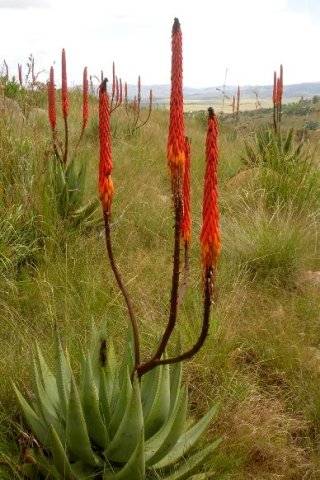Aloe reitzii var. reitzii

Author: Ivan Lätti
Photographer: Judd Kirkel Welwitch
Aloe reitzii var. reitzii is a leaf succulent growing mostly single rosettes, occasionally two or three. Usually stemless, old plants may occasionally develop short, inconspicuous ones.
The lance-shaped to sword-shaped leaves arch up, each tipped with a sharp, hard thorn. There are sharp, red-brown teeth along the margins and four to eight of them near the tip forming a keel on the outside. Otherwise the blades are smooth, unlined and unspotted. The upper surface is flat or slightly concave, the lower one convex. Blades are up to 65 cm long and 12 cm wide at the base.
The inflorescence of 1 m to 1,3 m long is a panicle comprising four to six erect racemes on mature plants, branched low down. The peduncle is covered in scattered sterile bracts above the first branching, up to the flowers where the bracts continue below each pedicel.
The cylindrical, many-flowered racemes become slightly narrower towards the top where a small tuft of wilted bracts lacking buds is usually present. Racemes are from 35 cm to 45 cm long. The buds and open flowers spread very slightly, pointing downwards, keeping the inflorescence narrow. The cylindrical and incurved perianths narrow to their mouths. They are dark red or scarlet, ageing to orange or dull yellow, up to 5 cm long.
Three of the six anthers are exserted slightly at a time in succession, brownish orange in the exserted parts. The style is also exserted. The ovary is 9 mm long in the flower, becoming 25 mm as a capsule.
Flowering happens at the end of summer and the beginning of autumn, although spring flowers are sometimes seen.
The distribution of the variety is in the south of Limpopo and in Mpumalanga from Roossenekal and Belfast to the Barberton Mountains.
The habitat is rocky grassland slopes. The variety is considered to be near threatened in its habitat early in the twenty first century, due to habitat loss and degradation from timber plantations, mining, quarrying and golf estates.
The other variety is var. vernalis found only in the northwest of KwaZulu-Natal (Reynolds, 1974; Van Wyk and Smith, 2003; http://redlist.sanbi.org).

